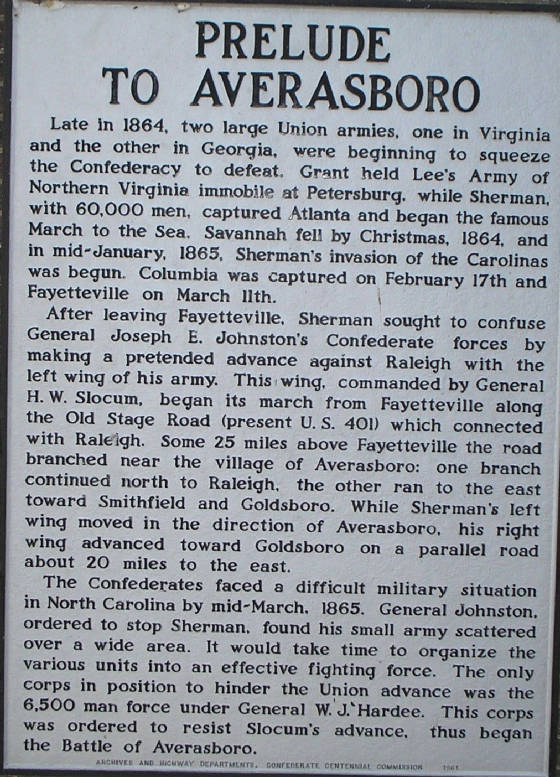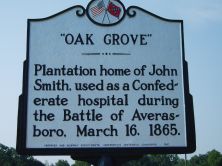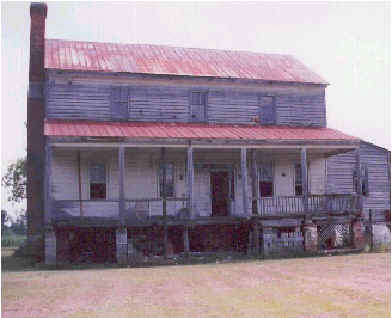|
Battle of Averasboro, aka Battle of Averasborough
| North Carolina Civil War Battle of Averasboro |

|
| North Carolina Battle of Averasboro |
Battle of Averasborough
On March 15th the left wing of General Sherman’s Union army, commanded
by General H. W. Slocum, was advancing from Fayetteville to Averasboro. General H. J. Kilpatrick’s
cavalry division was in the lead, skirmishing with General Joseph Wheeler’s Confederate cavalry which contested the
Union advance. (See also Battle of Averasboro: A History.)
At 3:00 P.M. the Union forces struck a heavy Confederate skirmish
line. General Smith Atkins’ 9th Michigan cavalry drove
the skirmishers back into the first of three lines of breastworks erected across the road. The Union cavalry then constructed
heavy barricades in front of the Confederate works.
At 6:00 P.M. Confederate General W. B. Taliaferro, whose
division was holding position, ordered an attack along his line. The Union forces, though hard-pressed, were able to hold
their position due to the arrival of reinforcements from the 14th Corps. Nightfall found the two armies in nearly the same
positions they had held throughout the afternoon. General W. T. Sherman, Union commander, arrived on the field during the
night.
At 6:00 A.M. on March 16th, the Union forces attacked Taliaferro’s
line, driving the Confederates before them. Then the Southerners launched a desperate counter-attack. A disaster for the Union
forces was averted when portions of the 20th Corps arrived upon the field. Three batteries of artillery were placed in the
position near the John Smith house. These began firing upon the Confederates, driving them back into their breastworks.
At 11:00 A.M. two newly-arrived
Union brigades engaged the Confederates in front, while the brigade of Colonel Henry Case assaulted the Confederate right
flank. This attack forced the Confederates to withdraw into their second line of works.
| Civil War Battle of Averasboro |

|
| (Historical Marker) |
On
the morning of March 16th, after the fight of the preceding afternoon around John Smith’s house 2 miles south of this
road, Union General H. J. Kilpatrick’s cavalry found a back road circled to the rear of the Confederate position. The
Union cavalry attempted to use this road to flank the Confederates, but was stopped by Colonel G. P. Harrison’s brigade
of McLaws’ division after moving only a short distance.
General W. B. Taliaferro decided to abandon the Confederate second position after finding his men in danger
of being flanked. At 1:00 P.M. he withdrew to the third and final line of earthworks, where he was assisted by McLaw’s
division on his left and Wheeler’s dismounted cavalry on his right. Rhett’s disorganized brigade was held in general
reserve.
The Union forces soon advanced and established a strong line immediately in front of the Confederate
third line. From this new position they pressed the Confederates all afternoon and part of the evening, but were unable to
break the line. At 8:00 P.M. General W. J. Hardee, commanding the Confederate forces at Averasboro, having accomplished his
objectives, began withdrawing his corps along the Smithfield road. Wheeler’s cavalry was left behind
to cover the retreat. By 4:00 A.M. on March 17th, all Confederate units had been withdrawn leaving the Union forces in control.
| John Smith House at Oak Grove (present-day) |

|
| Present-day John Smith House at Oak Grove |
General Hardee wished to accomplish two things by contesting the Union advance at Averasboro. The first
objective was to determine for General Joseph E. Johnston, commander of all Confederate forces in the Carolinas, whether Sherman’s army was
advancing on Raleigh or Goldsboro.
The Confederates learned it was moving on Goldsboro. The second
objective was to stretch out the distance between Sherman’s left and right wings (which were moving on parallel roads)
in order to give General Johnston a chance to concentrate his smaller army and destroy the Union left wing before the right
wing could come to its assistance. Both of these objectives were fully accomplished. The stage was now set for the greater Battle of Bentonville fought 25 miles east on March 19-21, 1865.
(Sources and related reading below.)
Recommended Reading: NO SUCH ARMY SINCE THE DAYS OF JULIUS CAESAR: Sherman's Carolinas Campaign from
Fayetteville to Averasboro (Discovering Civil War America). Description: General William T. Sherman's 1865 Carolinas
Campaign receives scant attention from most Civil War historians, largely because it was overshadowed by the Army of Northern
Virginia's final campaign against the Army of the Potomac. However, a careful examination
of this campaign indicates that few armies in all of military history accomplished more under more adverse conditions than
did Sherman's. Continued below…
Mark A. Smith and Wade Sokolosky,
both career military officers, lend their professional eye to the critical but often overlooked run-up to the seminal Battle
of Bentonville, covering March 11-16, 1865. Beginning with the capture of Fayetteville and the demolition of its Arsenal, Smith and
Sokolosky chronicle the Battle of Averasboro in greater detail than ever tackled before in this, the third volume of Ironclad's
"The Discovering Civil War America Series." In the two-day fight at Averasboro, Lt. Gen. William J. Hardee's Corps conducted
a brilliantly planned and well-executed defense in depth that held Sherman's
juggernaut in check for two full days. Having accomplished his objective, Hardee then broke off and disengaged. This delay
permitted General Joseph E. Johnston to concentrate his forces in preparation for what became the Battle of Bentonville. The
book includes new maps, abundant illustrations, and a detailed driving and walking tour for dedicated battlefield stompers.
Recommended Reading: On Sherman's Trail: The Civil War's North
Carolina Climax. Description: Join journalist and historian Jim Wise as he follows
Sherman's last march through the Tar Heel State from Wilson's
Store to the surrender at Bennett Place. Retrace the
steps of the soldiers at Averasboro and Bentonville. Learn about what the civilians faced as the Northern army approached
and view the modern landscape through their eyes. Whether you are on the road or in a comfortable armchair, you will enjoy
this memorable, well-researched account of General Sherman's North Carolina
campaign and the brave men and women who stood in his path.
Recommended Reading: Sherman's March Through the Carolinas.
Description: In retrospect, General William Tecumseh Sherman considered his march through the Carolinas the greatest of his
military feats, greater even than the Georgia
campaign. When he set out northward from Savannah with 60,000
veteran soldiers in January 1865, he was more convinced than ever that the bold application of his ideas of total war could
speedily end the conflict. Continued below…
John Barrett's story of what happened
in the three months that followed is based on printed memoirs and documentary records of those who fought and of the civilians
who lived in the path of Sherman's onslaught. The burning of Columbia, the battle of Bentonville, and Joseph E. Johnston's
surrender nine days after Appomattox are at the center of the story, but Barrett also focuses on other aspects of the campaign,
such as the undisciplined pillaging of the 'bummers,' and on its effects on local populations. About the Author: John G. Barrett
is professor emeritus of history at the Virginia Military Institute. He is author of several books, including The Civil War
in North Carolina, and coeditor of North Carolina Civil
War Documentary.
Recommended Reading: The Battle Of Bentonville: Last Stand In The Carolinas,
by Mark L. Bradley (Hardcover). Description: Mark L. Bradley's book could not have come at a more proper time. The terrible
fighting that took place in the fields of North Carolina
in March of 1865 has been long forgotten; thankfully, Mr. Bradley has reminded us of the sacrifices that our ancestors endured
on that sacred ground. Bentonville is a stirring reminder of the American spirit...something that was exhibited on both sides
of the lines during those fateful three days in March. Mr. Bradley has written a stirring tribute to the two armies that fought
in this last great battle that pitted the forces of "Uncle Billy" Sherman, against his old
nemesis "Old Joe" Johnston. Continued below…
Mr.
Bradley has written an outstanding account of the soldiers who fought this landmark battle in the waning days of the war,
and he has given us a thorough look at what was going on in the minds of the Generals who led their soldiers to the killing
fields of Bentonville. Bradley has also included an outstanding photo collection of the battlefield as it appears today, something
that is rarely added to most of the narratives on Civil War battles. These photos give us an understanding of the terrain
that each man, Union
or Confederate, faced on those days in March 1865. I heartily recommend this narrative to all students of the Civil War. The
Battle of Bentonville has been neglected too long. Thankfully, Mr. Bradley has corrected that mistake, and he has provided
us buffs with a truly compelling story. Special appreciation is due to Mark A. Moore. Mr. Moore's maps of the campaign are
outstanding, and they help the reader understand and comprehend the many troop movements of this last major battle of the
Civil War in the Eastern Theater.
Recommended Reading: Sherman's March: The First Full-Length Narrative of General William T. Sherman's
Devastating March through Georgia and the Carolinas.
Description: Sherman's March is the vivid narrative of General William T. Sherman's devastating
sweep through Georgia and the Carolinas
in the closing days of the Civil War. Weaving together hundreds of eyewitness stories, Burke Davis graphically brings to life
the dramatic experiences of the 65,000 Federal troops who plundered their way through the South and those of the anguished
-- and often defiant -- Confederate women and men who sought to protect themselves and their family treasures, usually in
vain. Dominating these events is the general himself -- "Uncle Billy" to his troops, the devil incarnate to the Southerners
he encountered.
Sources: Mark L. Bradley, Last Stand in the Carolinas: The Battle of Bentonville
(1996); Mark A. Moore, Moore’s Historical Guide to the Battle of Bentonville (1997); John G. Barrett, Sherman’s
March Through the Carolinas (1956); Wilson Angley, Jerry L. Cross, and Michael Hill, Sherman’s March through North Carolina:
A Chronology (1995).
|

